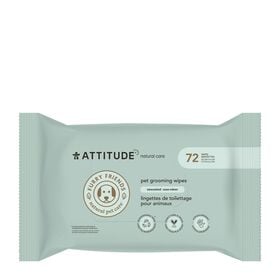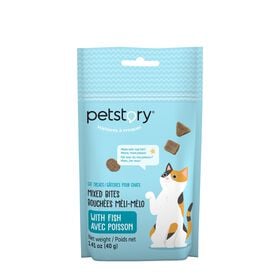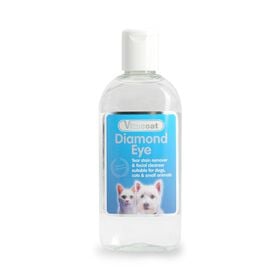As a pet parent, you have the power to keep your furry friend healthy and happy! Establishing a consistent hygiene routine ensures that your pet's eyes, ears, and muzzle stay clean and healthy. This will not only prevent potential health issues but also promote your pet's overall well-being. So, let's get grooming!
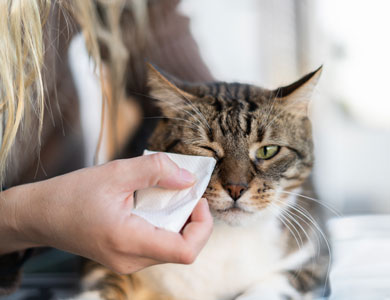
Why establish a care routine?
Your pet's eyes, ears, and nose are delicate areas that can accumulate dirt and bacteria over time. These accumulations can lead to irritations, infections, and other serious health problems if not cleaned regularly.
Moreover, regular maintenance of these areas helps detect early signs of underlying health issues. For instance, regular eye check-ups can reveal signs of conjunctivitis, while ear cleaning can help prevent infections and maintain good hearing.
Finally, caring for your pet's eyes, ears, and nose is essential for their overall health and the bond you share with them. It's a great way to spend quality time together while looking after their well-being.
Also read : Cat grooming: do you need to give your cat a bath?
Eye cleaning guide
Your pet's eyes are precious and deserve special attention.
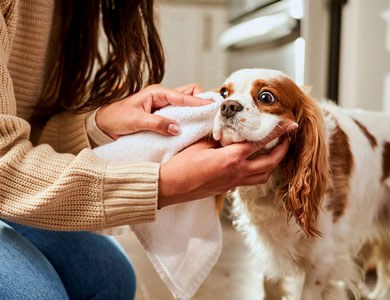
Signs of ocular problems
Before you start cleaning, ensure you know how to recognize the signs of eye problems in your pet. These may include redness, excessive discharge, frequent blinking, or any sign of discomfort around the eyes. If in doubt, consult your veterinarian promptly.
Choosing suitable products
Opt for a gentle and pet-safe eye solution. We have a few options in-store, or your veterinarian can recommend one. Avoid using cotton swabs, as they can cause injuries to the eye.
Eye care steps
To prevent the formation of dark circles under the eyes, clean them daily.
- Wash your hands before starting and gently pet your pet to calm them.
- Use a clean and soft cloth to wipe your pet's eyes from the inner to the outer corner.
- Use a different cloth for each eye to prevent the spread of potential infections.
- Use cleansing lotions or wet wipes if your pet has noticeable dark circles.
- Reward your pet with treats or cuddles to reinforce positive association with eye cleaning.
Good to know
- Flat-faced dog and cat breeds like French bulldogs and Persians are more prone to watery eyes because of blocked tear ducts. It can cause reddish discharges that can stain the fur around their eyes.
- For other breeds, this problem may be caused by overly long hair near the eyes. In this case, ask your groomer or veterinarian to trim it.
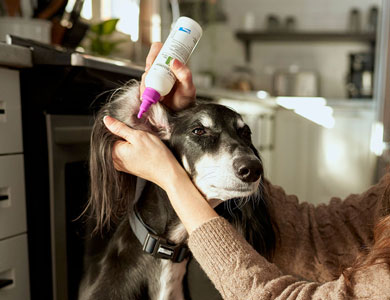
Ear care guide
Your pet's ears are also sensitive and need regular care to avoid infection and irritation.
Dogs can have three different types of ears:
- Drop or floppy ears
- Rose ears
- Prick ears
If your pet has floppy ears or recurring ear problems, it is crucial to clean them regularly, at least once a week, to prevent ear infections and other issues associated with wax build-up. However, if your pet has rose or prick ears, you can clean them once or twice a month.
Neglecting to clean your pet's ears can lead to a build-up of earwax or dirt that can encourage the growth of bacteria and yeast, leading to painful and itchy infections.
Symptoms to watch for
Look for signs of infection, such as frequent head shaking, excessive ear scratching, an unpleasant odour or unusual discharge. If you notice any of these signs, consult your veterinarian for an accurate diagnosis.
Safe and effective cleaning method
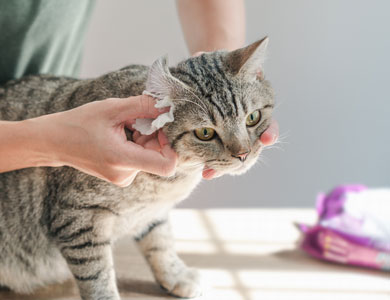
Cleaning your pet's ears at home is simple, especially if you start when they are young. To clean their ears, use a product specifically made for cleaning ear canals and follow these steps:
- Find a quiet place and ask for help keeping your pet still. Doing so will make the following steps easier.
- Before cleaning your pet's ears, visually inspect them for any signs of irritation or infection.
- Use a cleaner specially formulated for pets, carefully following the instructions on the packaging.
- Pour a small amount of the cleaning solution into your pet's ear. Once the canal is filled, gently massage the base of the ear to get gunk out.
- After massaging for a few minutes, use a clean cloth to wipe away any dirt that has surfaced. Avoid inserting sharp objects or cotton swabs into the ear canal, as they could cause injury or irritation
- Allow your pet to shake its head to help empty the ear.
- Wipe the external part of the ear with a soft cloth or tissue.
- Remember to reward your companion for their cooperation.
Also read: Washing your dog: tips and tricks for getting the job done
Muzzle care guide
Your dog's sense of the world is closely linked to their muzzle. Here are some tips on caring for it.
Tips for a clean and moisturized muzzle
Use a compress soaked in previously boiled warm water to clean your pet's nose and remove accumulated dirt or secretions.
Additionally, you might want to apply moisturizing balm to keep it from drying out. This product is also suitable for treating dry and cracked paw pads, as it is designed to soothe, nourish, and maintain skin flexibility. It helps protect against the cold, salt, and other abrasives in winter, while in summer, it prevents drying due to heat and hot surfaces.
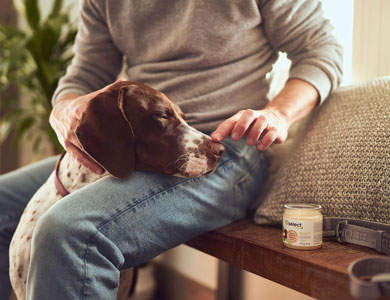
Signs to watch for
Look for any dryness, scaling or irritation around your pet's muzzle. These symptoms may indicate skin irritation or an underlying infection. In the event of profuse or yellowish discharge, consult your veterinarian.
Practical tips
- Make eye, ear and muzzle cleaning part of your pet's daily grooming routine. The more regularly you do it, the easier it will be for you and your pet.
- Reward your pet after each cleaning session with treats or petting to reinforce the positive association with this activity.
- Pay close attention to your pet's reactions during cleaning. If they show discomfort or pain, stop immediately and consult your veterinarian.
By consistently checking your furry friend's eyes, ears, and snout, you ensure their health and happiness for years to come!



